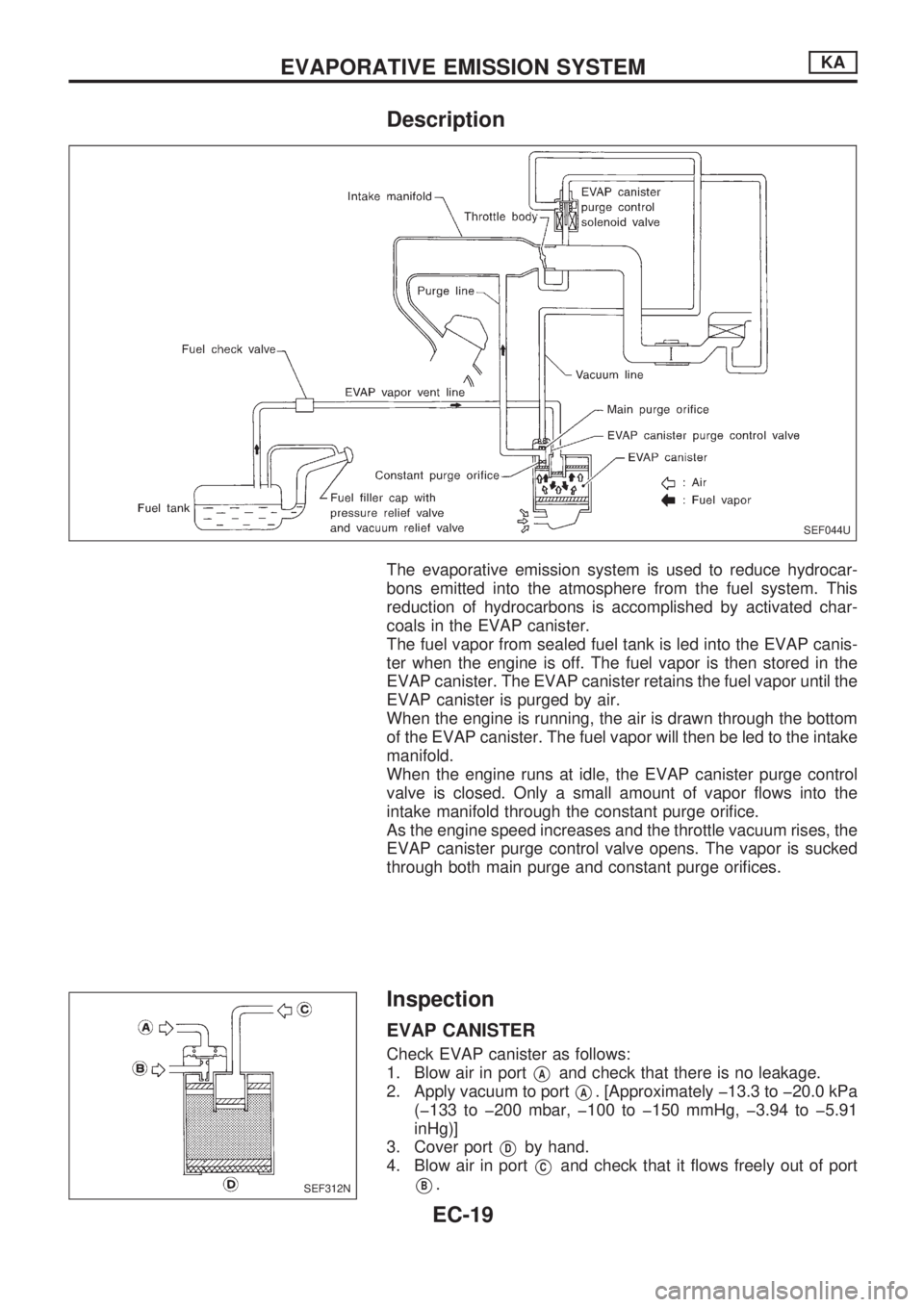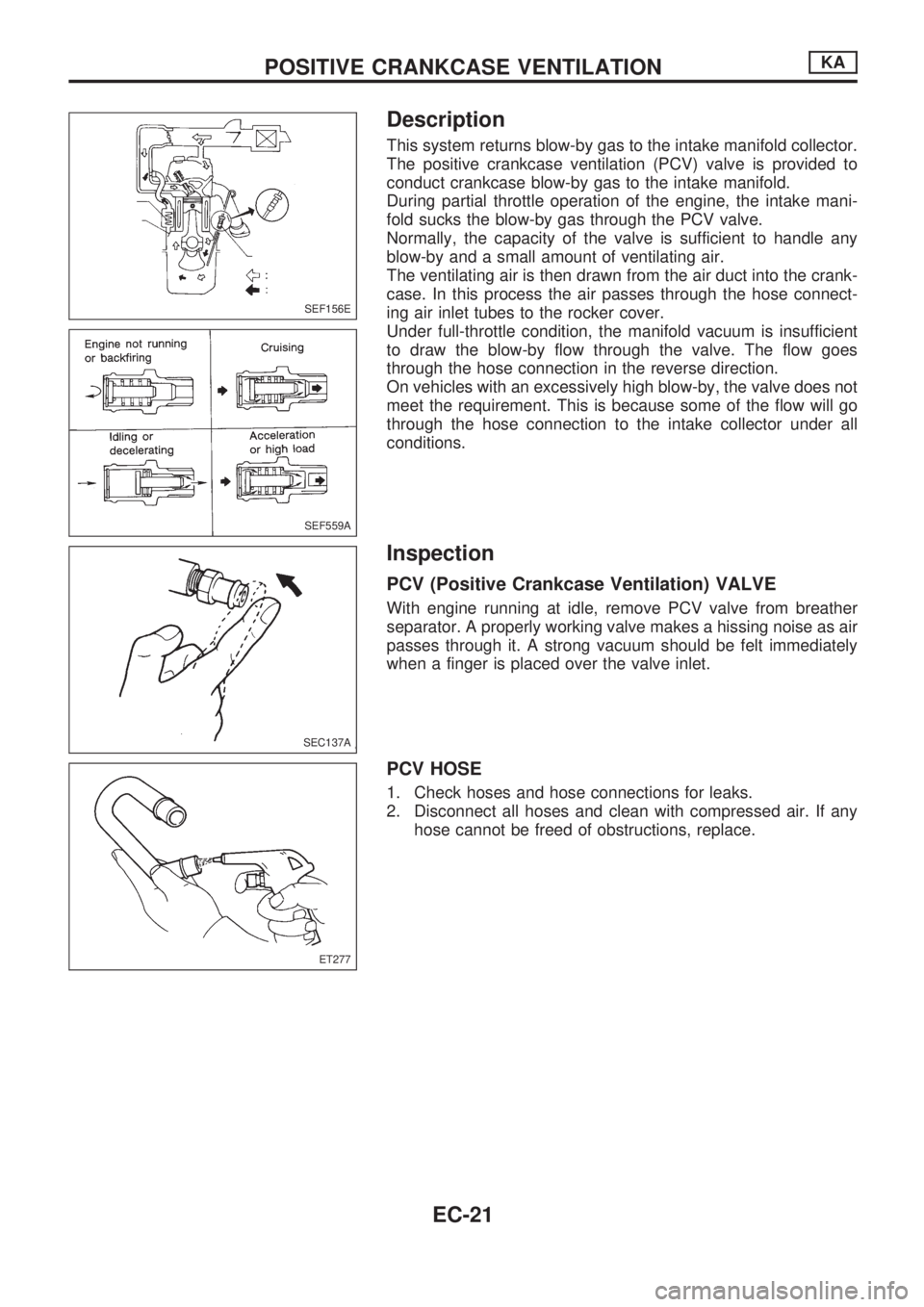Page 165 of 1659
System Chart
Camshaft position sensorc
ECM
(ECCS
control
module)
Mass air flow sensorc
Engine coolant temperature sensorc
Heated oxygen sensor*c
Ignition switchc
Throttle position sensorc
Neutral position switchc
Vehicle speed sensorc
Air conditioner switchc
Battery voltagec
Power steering oil pressure switchc
Intake air temperature sensorc
*: LHD models
Fuel injection &
mixture ratio controlcInjectors
Distributor ignition systemcPower transistor
Idle air control systemcIACV-AAC valve
IACV-FICD solenoid valve
Swirl control valve controlcSwirl control valve control
solenoid valve
EVAP canister controlcEVAP canister purge control
solenoid valve
Fuel pump controlcFuel pump relay
Heated oxygen sensor moni-
tor & on board diagnostic
systemcMalfunction indicator lamp
(On the instrument panel)
Acceleration cut controlcAir conditioner relay
Heated oxygen sensor
heater control*cHeated oxygen sensor
heater
ENGINE AND EMISSION CONTROL OVERALL SYSTEMKA
EC-13
Page 166 of 1659

Multiport Fuel Injection (MFI) System
INPUT/OUTPUT SIGNAL LINE
Camshaft position sensorcEngine speed and piston position
ECM
(ECCS
control
module)
cInjector
Mass air flow sensorcAmount of intake air
Engine coolant temperature sensor
cEngine coolant temperature
Heated oxygen sensor*
cDensity of oxygen in exhaust gas
Throttle position sensor
cThrottle position
Throttle valve idle position
Neutral position switch
cGear position
Vehicle speed sensor
cVehicle speed
Ignition switch
cStart signal
Battery
cBattery voltage
*: LHD models
BASIC MULTIPORT FUEL INJECTION
SYSTEM
The amount of fuel injected from the fuel injector is
determined by the ECM. The ECM controls the
length of time the valve remains open (injection
pulse duration). The amount of fuel injected is a
program value in the ECM memory. The program
value is preset by engine operating conditions.
These conditions are determined by input signals
(for engine speed and intake air) from both the
camshaft position sensor and the mass air flow
sensor.
VARIOUS FUEL INJECTION
INCREASE/DECREASE COMPENSATION
The amount of fuel injected is compensated for to
improve engine performance. This will be made
under various operating conditions as listed below.
lDuring warm-up
lWhen starting the engine
lDuring acceleration
lHot-engine operation
lHigh-load, high-speed operation
lWhen swirl control valve operates
lDuring deceleration
lDuring high-engine speed operation
lExtremely high-engine coolant temperature
ENGINE AND EMISSION BASIC CONTROL SYSTEM DESCRIPTIONKA
EC-14
Page 167 of 1659

MIXTURE RATIO FEEDBACK CONTROL
The mixture ratio feedback system provides the best air-fuel
mixture ratio for driveability and emission control. The three way
catalyst can then better reduce CO, HC and NOx emissions. This
system uses a heated oxygen sensor in the exhaust manifold to
monitor if the engine is rich or lean. The ECM adjusts the injec-
tion pulse width according to the sensor voltage signal. For more
information about heated oxygen sensor, refer to page EC-123.
This maintains the mixture ratio within the range of stoichiomet-
ric (ideal air-fuel mixture).
This stage is referred to as the closed loop control condition.
OPEN LOOP CONTROL
The open loop system condition refers to when the ECM detects
any of the following conditions. Feedback control stops in order
to maintain stabilized fuel combustion.
lDeceleration and acceleration
lHigh-load, high-speed operation
lEngine idling
lMalfunction of heated oxygen sensor or its circuit
lInsufficient activation of heated oxygen sensor at low engine
coolant temperature
lHigh-engine coolant temperature
lDuring warm-up
lWhen starting the engine
MIXTURE RATIO SELF-LEARNING CONTROL
The mixture ratio feedback control system monitors the mixture
ratio signal transmitted from the heated oxygen sensor. This
feedback signal is then sent to the ECM. The ECM controls the
basic mixture ratio as close to the theoretical mixture ratio as
possible. However, the basic mixture ratio is not necessarily con-
trolled as originally designed. Both Manufacturing differences
(i.e. mass air flow sensor hot wire) and characteristic changes
during operation (i.e. injector clogging) directly affect mixture
ratio.
Accordingly, the difference between the basic and theoretical
mixture ratios is monitored in this system. This is then computed
in terms of ``injection pulse duration'' to automatically compen-
sate for the difference between the two ratios.
FUEL INJECTION SYSTEM
Two types of systems are used.
Sequential multiport fuel injection system
Fuel is injected into each cylinder during each engine cycle
according to the firing order. This system is used when the
engine is running.
MEF025DD
MEF522D
ENGINE AND EMISSION BASIC CONTROL SYSTEM DESCRIPTIONKA
Multiport Fuel Injection (MFI) System
(Cont'd)
EC-15
Page 168 of 1659
Simultaneous multiport fuel injection system
Fuel is injected simultaneously into all four cylinders twice each
engine cycle. In other words, pulse signals of the same width are
simultaneously transmitted from the ECM.
The four injectors will then receive the signals two times for each
engine cycle.
This system is used when the engine is being started and/or if
the fail-safe mode (CPU) is operating.
FUEL SHUT-OFF
Fuel to each cylinder is cut off during deceleration or operation
of the engine at excessively high speeds.
MEF523D
ENGINE AND EMISSION BASIC CONTROL SYSTEM DESCRIPTIONKA
Multiport Fuel Injection (MFI) System
(Cont'd)
EC-16
Page 169 of 1659

Distributor Ignition (DI) System
INPUT/OUTPUT SIGNAL LINE
Camshaft position sensorcEngine speed and piston position
ECM
(ECCS
control
module)
cPower
transistor
Mass air flow sensorcAmount of intake air
Engine coolant temperature sensor
cEngine coolant temperature
Throttle position sensor
c
Throttle position
Throttle valve idle position
Vehicle speed sensor
cVehicle speed
Ignition switch
cStart signal
Intake air temperature sensor
cIntake air temperature
Neutral position switch
cGear position
Battery
cBattery voltage
SYSTEM DESCRIPTION
The ignition timing is controlled by the ECM to maintain the best
air-fuel ratio for every running condition of the engine.
The ignition timing data is stored in the ECM. This data forms the
map shown left.
The ECM detects information such as the injection pulse width
and camshaft position sensor signal. Responding to this
information, ignition signals are transmitted to the power transis-
tor.
e.g. N: 1,800 rpm, Tp: 1.50 msec
A ÉBTDC
During the following conditions, the ignition timing is revised by
the ECM according to the other data stored in the ECM.
1 At starting
2 During warm-up
3 At idle
4 When swirl control valve operates
5 Hot-engine operation
6 At acceleration
SEF742M
ENGINE AND EMISSION BASIC CONTROL SYSTEM DESCRIPTIONKA
EC-17
Page 170 of 1659

Air Conditioning Cut Control
INPUT/OUTPUT SIGNAL LINE
Air conditioner switchcAir conditioner ``ON'' signal
ECM
(ECCS
control
module)
cAir condi-
tioner
relayThrottle position sensorcThrottle valve opening angle
Ignition switch
cStart signal
Engine coolant temperature sensor
cEngine coolant temperature
SYSTEM DESCRIPTION
This system improves engine operation when the
air conditioner is used.
Under the following conditions, the air conditioner
is turned off.
lWhen the accelerator pedal is fully depressed
lWhen cranking the engine
lWhen the engine coolant temperature becomes
excessively high
Fuel Cut Control (at no load & high engine
speed)
INPUT/OUTPUT SIGNAL LINE
Vehicle speed sensorcVehicle speed
ECM
(ECCS
control
module)
cInjectors
Neutral position switchcNeutral position
Throttle position sensor
cThrottle position
Engine coolant temperature sensor
cEngine coolant temperature
Camshaft position sensor
cEngine speed
If the engine speed is above 3,500 rpm with no load (for
example, in neutral and engine speed over 3,500 rpm) fuel will
be cut off after some time. The exact time when the fuel is cut
off varies based on engine speed.
Fuel cut will operate until the engine speed reaches 1,500 rpm,
then fuel cut is cancelled.
NOTE:
This function is different than deceleration control listed
under multiport fuel injection on EC-14.
ENGINE AND EMISSION BASIC CONTROL SYSTEM DESCRIPTIONKA
EC-18
Page 171 of 1659

Description
The evaporative emission system is used to reduce hydrocar-
bons emitted into the atmosphere from the fuel system. This
reduction of hydrocarbons is accomplished by activated char-
coals in the EVAP canister.
The fuel vapor from sealed fuel tank is led into the EVAP canis-
ter when the engine is off. The fuel vapor is then stored in the
EVAP canister. The EVAP canister retains the fuel vapor until the
EVAP canister is purged by air.
When the engine is running, the air is drawn through the bottom
of the EVAP canister. The fuel vapor will then be led to the intake
manifold.
When the engine runs at idle, the EVAP canister purge control
valve is closed. Only a small amount of vapor flows into the
intake manifold through the constant purge orifice.
As the engine speed increases and the throttle vacuum rises, the
EVAP canister purge control valve opens. The vapor is sucked
through both main purge and constant purge orifices.
Inspection
EVAP CANISTER
Check EVAP canister as follows:
1. Blow air in port
VAand check that there is no leakage.
2. Apply vacuum to port
VA. [Approximately þ13.3 to þ20.0 kPa
(þ133 to þ200 mbar, þ100 to þ150 mmHg, þ3.94 to þ5.91
inHg)]
3. Cover port
VDby hand.
4. Blow air in port
VCand check that it flows freely out of port
VB.
SEF044U
SEF312N
EVAPORATIVE EMISSION SYSTEMKA
EC-19
Page 173 of 1659

Description
This system returns blow-by gas to the intake manifold collector.
The positive crankcase ventilation (PCV) valve is provided to
conduct crankcase blow-by gas to the intake manifold.
During partial throttle operation of the engine, the intake mani-
fold sucks the blow-by gas through the PCV valve.
Normally, the capacity of the valve is sufficient to handle any
blow-by and a small amount of ventilating air.
The ventilating air is then drawn from the air duct into the crank-
case. In this process the air passes through the hose connect-
ing air inlet tubes to the rocker cover.
Under full-throttle condition, the manifold vacuum is insufficient
to draw the blow-by flow through the valve. The flow goes
through the hose connection in the reverse direction.
On vehicles with an excessively high blow-by, the valve does not
meet the requirement. This is because some of the flow will go
through the hose connection to the intake collector under all
conditions.
Inspection
PCV (Positive Crankcase Ventilation) VALVE
With engine running at idle, remove PCV valve from breather
separator. A properly working valve makes a hissing noise as air
passes through it. A strong vacuum should be felt immediately
when a finger is placed over the valve inlet.
PCV HOSE
1. Check hoses and hose connections for leaks.
2. Disconnect all hoses and clean with compressed air. If any
hose cannot be freed of obstructions, replace.
SEF156E
SEF559A
SEC137A
ET277
POSITIVE CRANKCASE VENTILATIONKA
EC-21